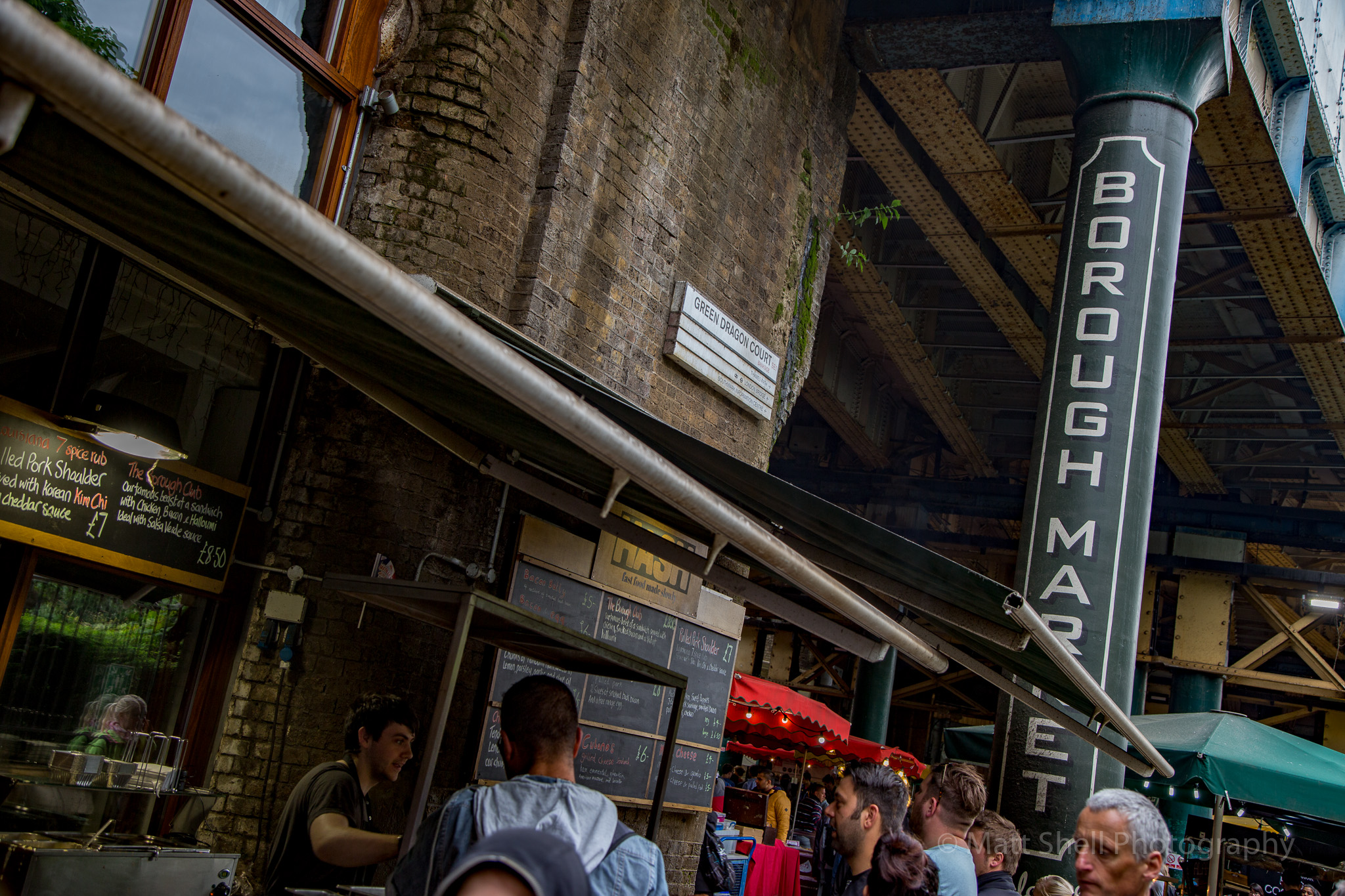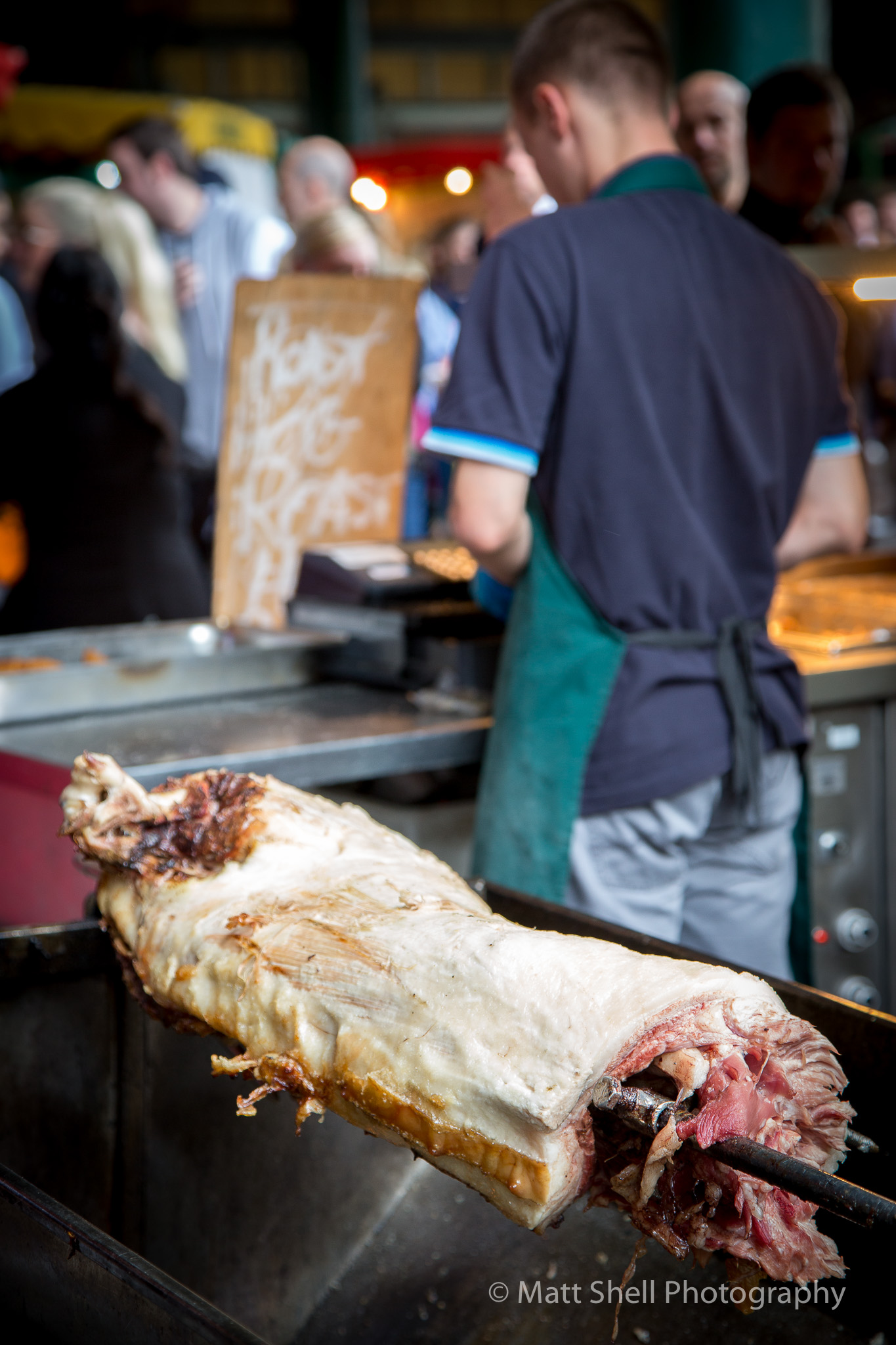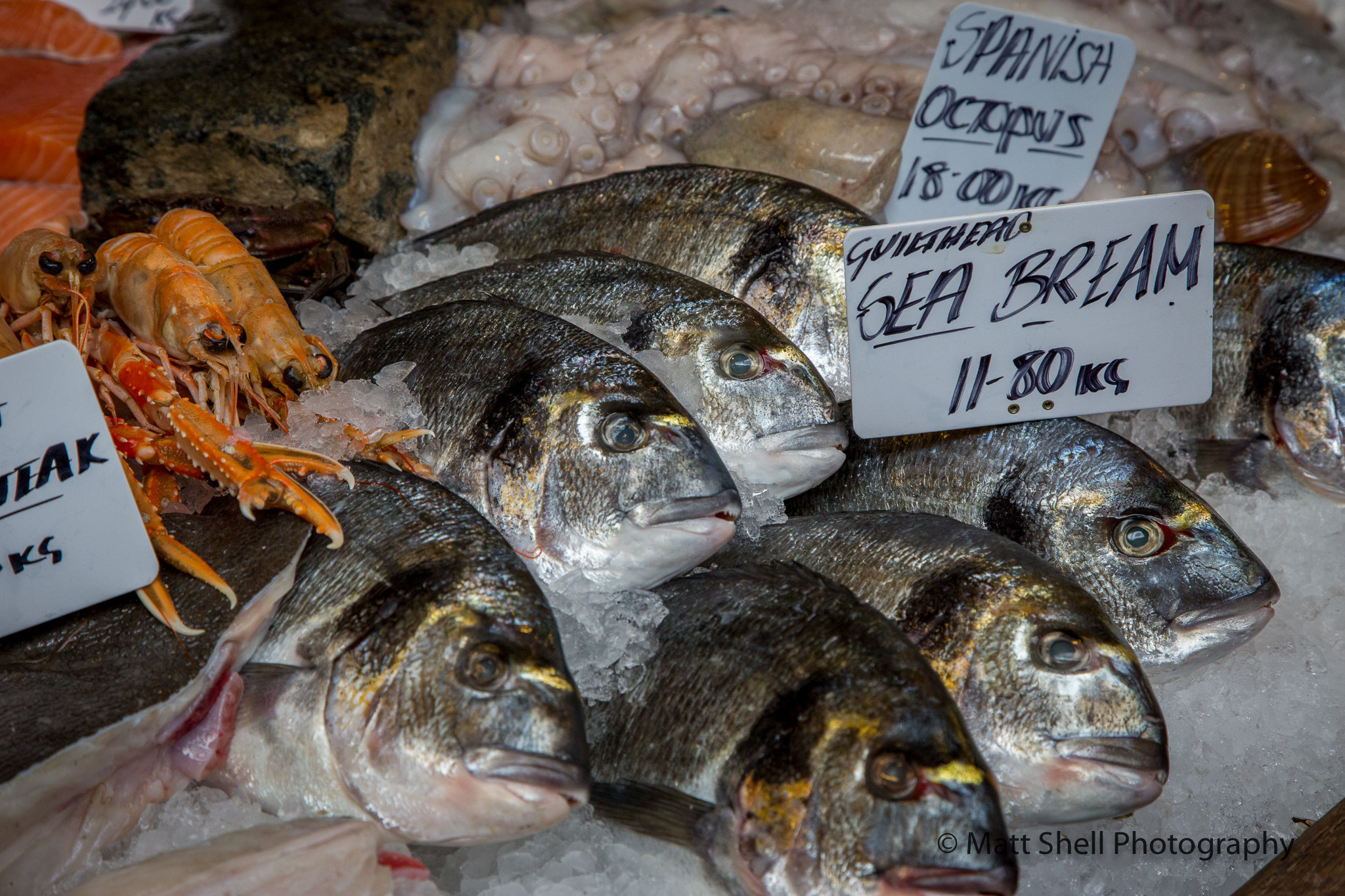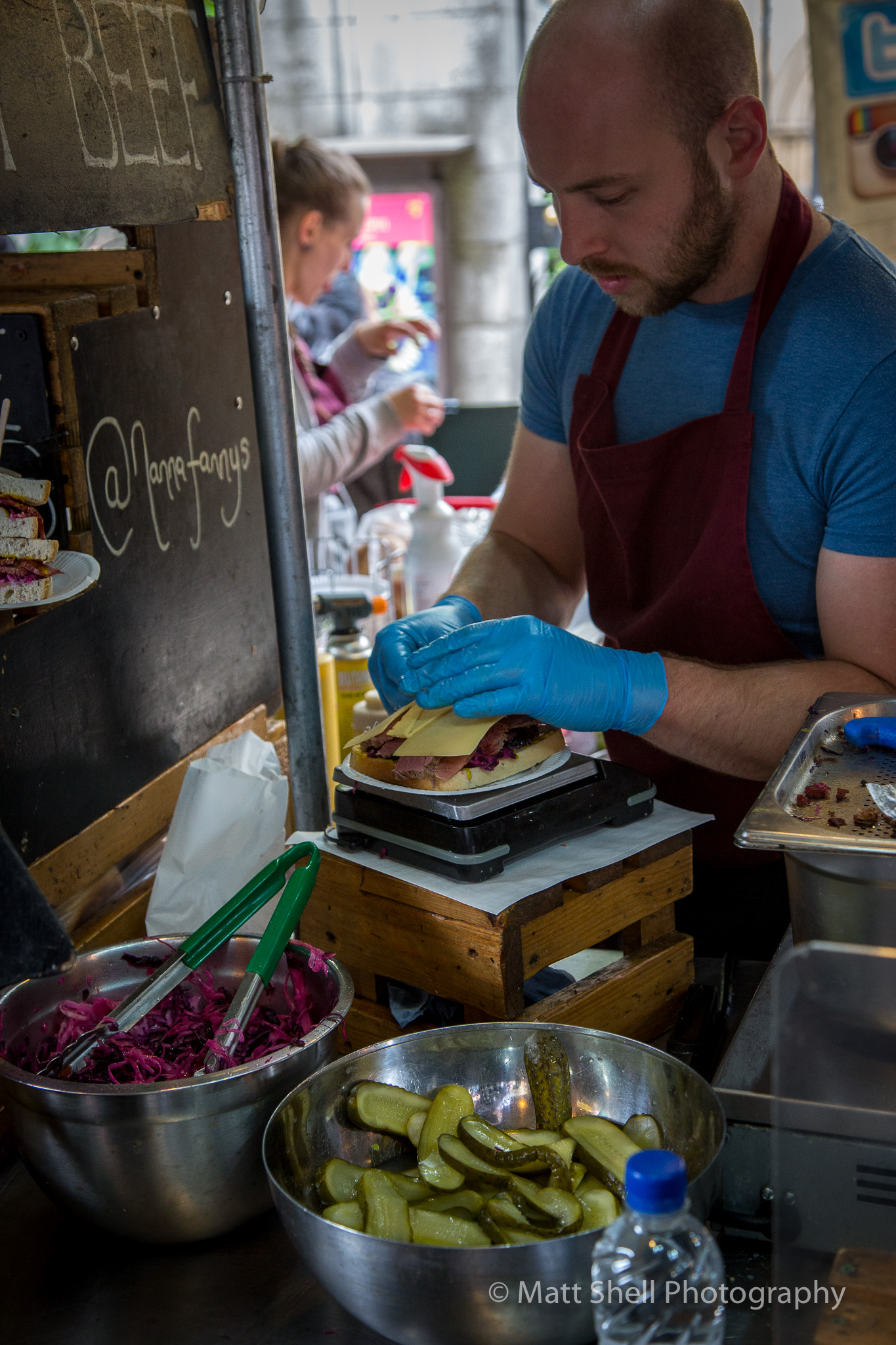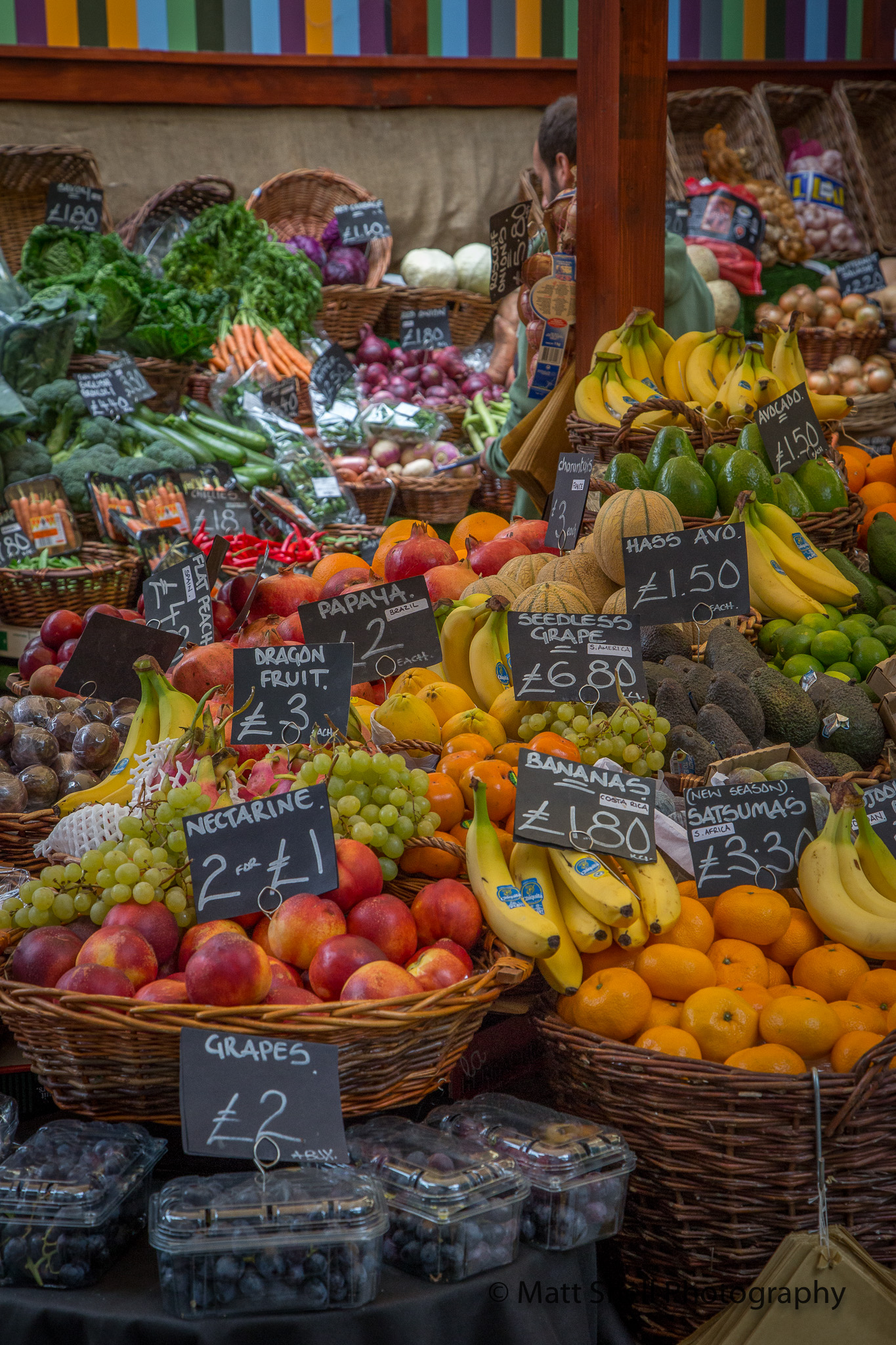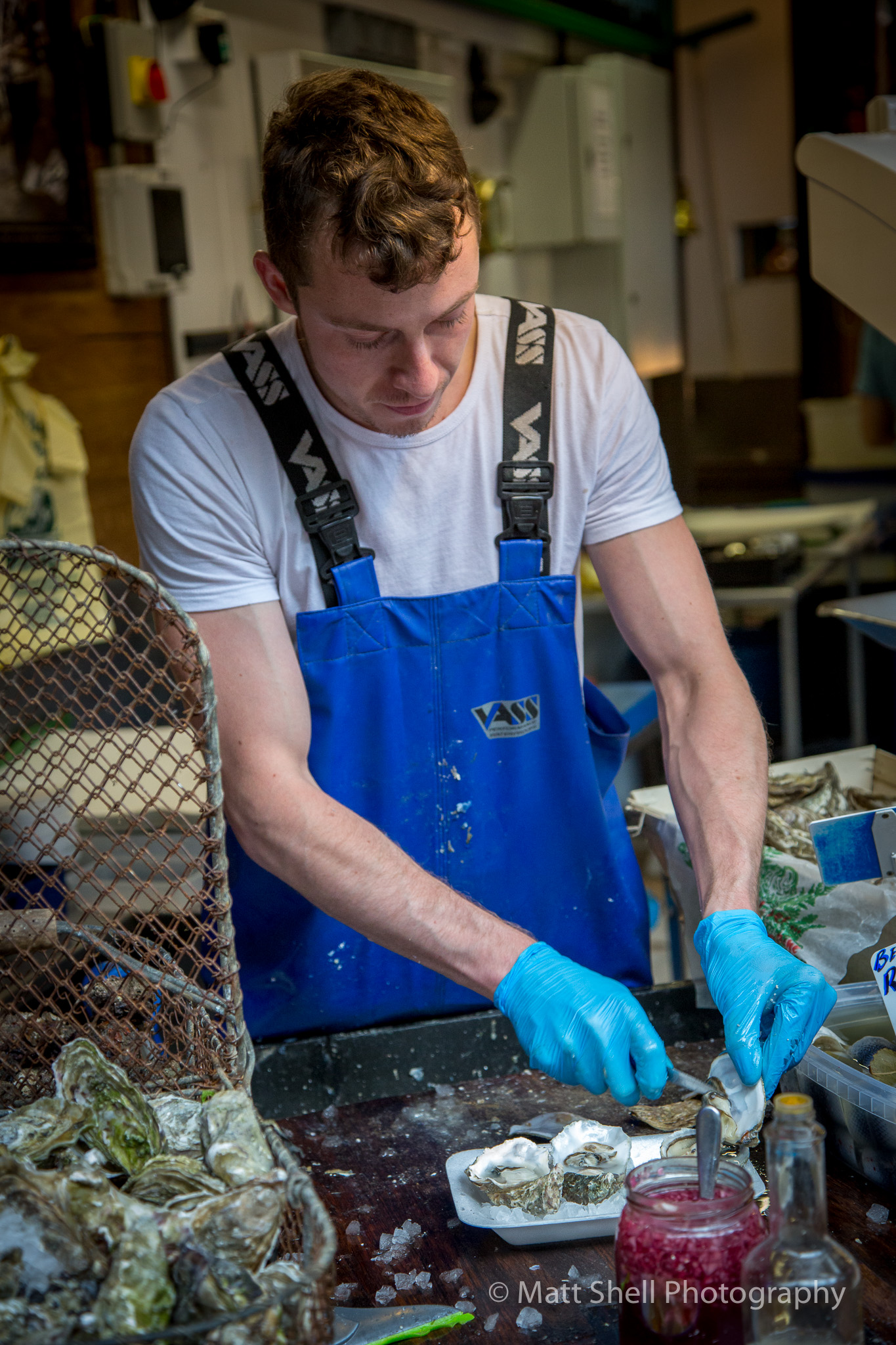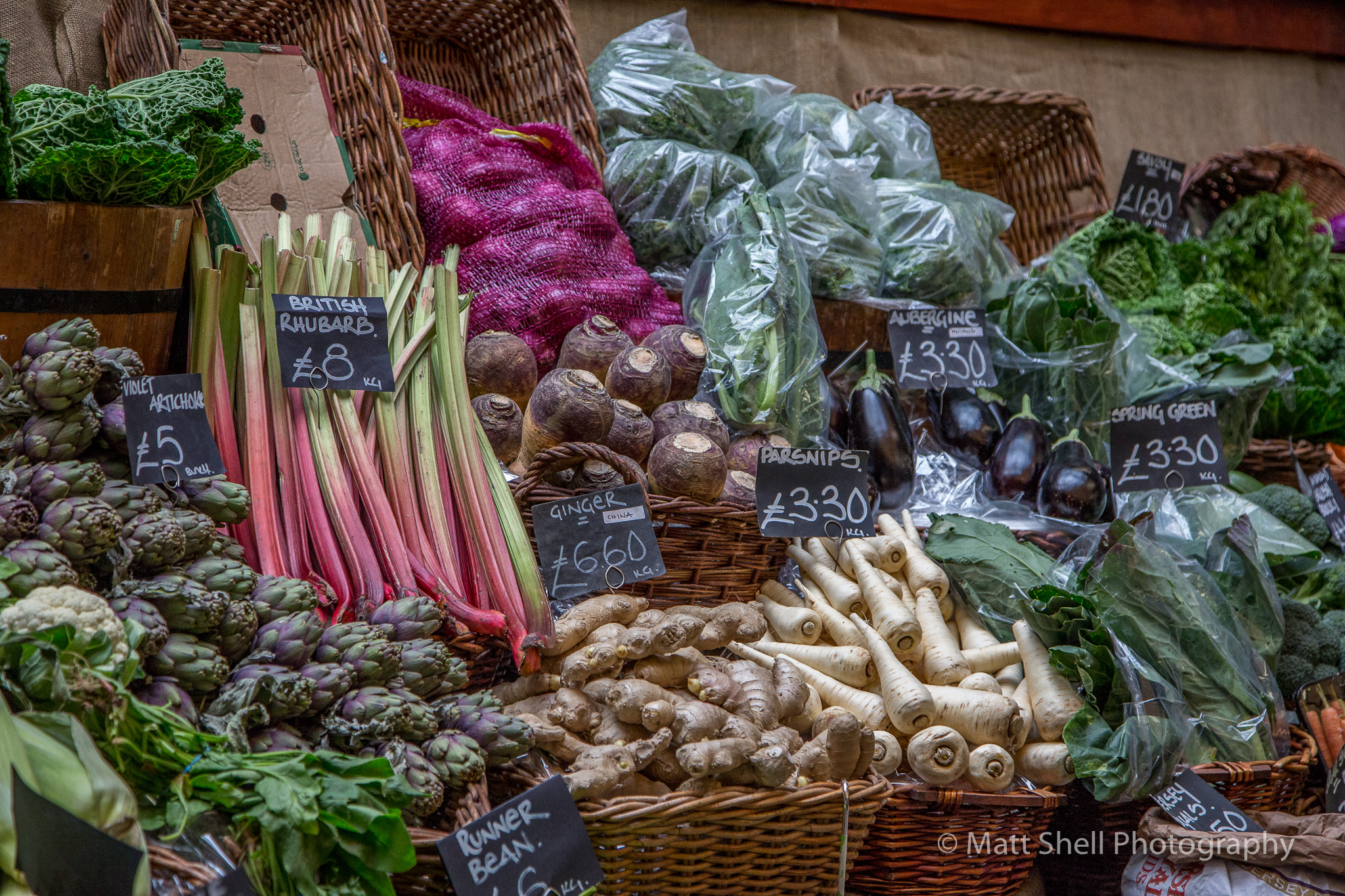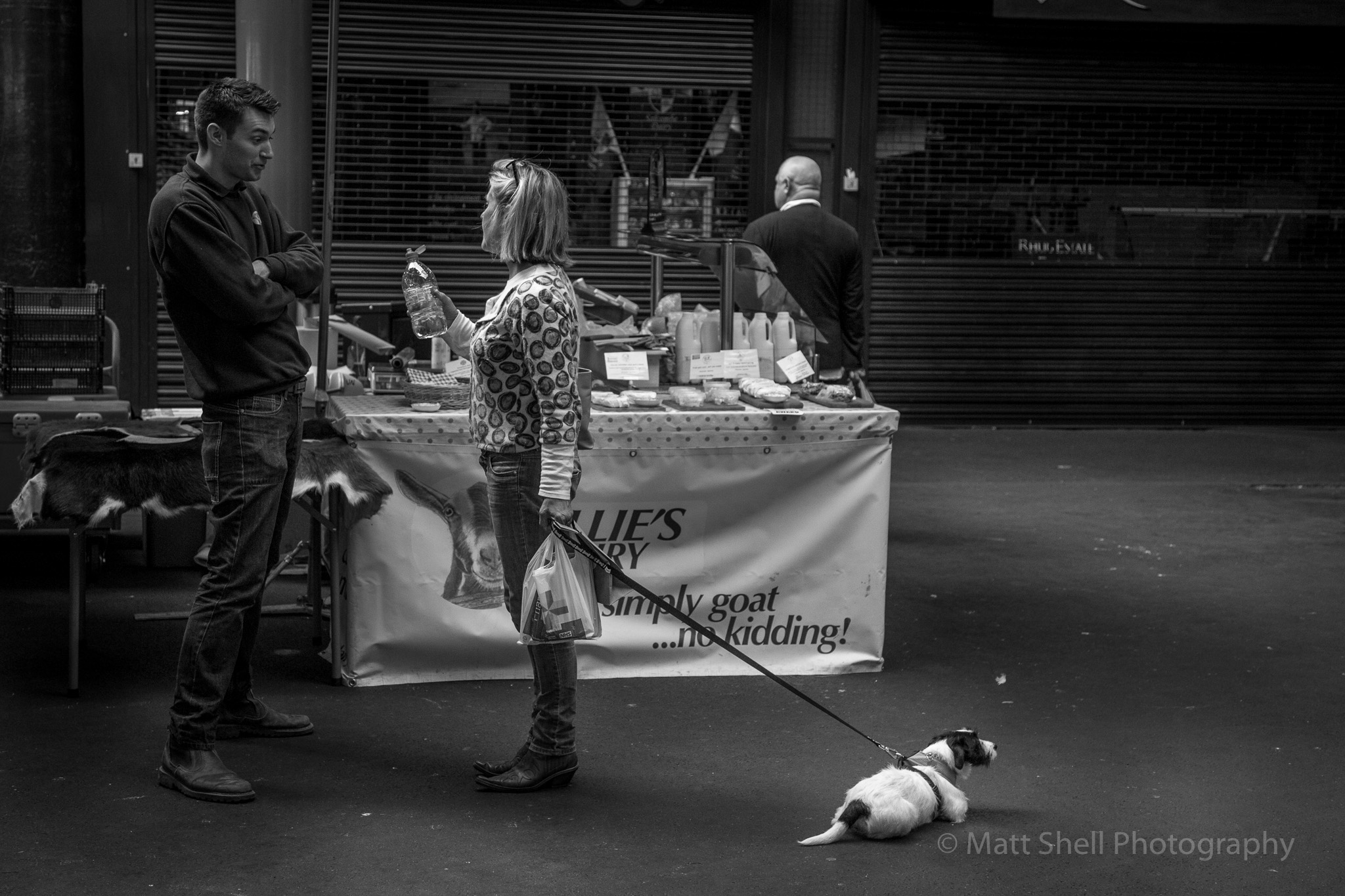Today's England photos come courtesy of one of my favorite places in London. The Borough Market. The market is rich with history, but it remains as relevant now as it has ever been. As London’s oldest food market, it has been serving the people of Southwark for 1,000 years, and that extraordinary heritage is an important part of its appeal. Its precise start date is impossible to pin down: there was no official opening, no ribbon-cutting ceremony, not even a brief mention in a chronicle. The best date available, and the one used as the basis for the Market’s millennium celebration, is 1014. The present market is located on Southwark Street and Borough High Street just south of Southwark Cathedral on the southern end of London Bridge. This place is amazing, and a food lovers paradise. The present-day market mainly sells speciality foods to the general public. However, in the 20th century, it was essentially a wholesale market, selling produce in quantity to greengrocers. It was the main supplier, along with Covent Garden, of fruits and vegetables to retail greengrocers shops. It has dozens and dozens of stalls that sell everything from tomatoes to truffles, cheese to fresh breads, and every kind of meat or seafood you can imagine. It also has tons to booths selling freshly prepared food. So, if you want a salt beef sandwich or a plate of paella... this is the place to come. If you love food... this is a place not to be missed. The food is beautiful, the people are so nice and everything is delicious. How do I know? Because everybody will let you taste everything... and believe me... I did! If I had to pick a favorite, though, and I'm glad I don't... It would be the salt beef sandwiches. They're like a hot corned beef, but at the market, they're served with homemade pickles, pickled cabbage and top with cheese that they caramelize with a blow torch!! Seriously amazing!
A Walk Through the Park
Today's London photos come courtesy of my walk home through Hyde Park. I love this place and try to walk through it any time I'm town. It's like Central Park in New York, except everybody has cool accents. It's a beautiful place and like most typical London days, it started to rain during my trek. That didn't stop me, or the parrots from showing up.
The first picture is a shot through the trees of a fountain near the Marble Arch. The fountain had tons of people around it, so taking the shot through the trees allowed me to keep the tourists out of the shot and made for a nice frame. Shot at 1/500 sec at f/7.1, ISO 100.
The second shot is one of a number I got of the wild parrots that can be found in the park. Trust me, you'll know when you're close to finding them. They're not quiet. I saw a ton, but this guy seemed to want to have his picture taken, so this was a favorite. Shot at 1/320 sec at f/5.0, ISO 1600. I had to bump up the ISO in this shot cause the clouds were coming in and it was actually pretty dark under the tree canopy.
Finally, this shot of a bridge over the lake in Hyde Park. I'm sure it has a name I should know, but I don't... so don't ask. I processed this phone in Color Efex 4.0. I needed to process it cause there were a lot of blurry spots in this photo. Truth is, I actually got rain drops on my lens and took a bunch of photos without noticing. So a little color, a little blur, some contrast and wham-o bam-o, this is what I ended up liking. Shot at 15 sec on a tripod at f/22, ISO 100.
It's night time in London!
Two more of my favorite photos from my trip to London. Today's favorites were both taken at about the same time in almost the same place... The first is a long exposure taken on the Westminster Bridge of Big Ben. I took a similar picture on the Tower Bridge the last time I was here, but I've always wanted to take one with the famous clock in the background. I love this city and this location, so this shot was a goal of mine on this trip. I took a ton of photos at this location trying to get the lights on the cars just right. I wanted the light streaks at different levels, so I waited for busses, cars, bikes... anything with a light! It seemed like every time there were the right cars, there were no busses, and every time there were buses, there were no cars. I really need the busses and the cars in order to get the right amount of lights at the right nights. It took about 25 minutes to get the shot I was looking for. You'd be surprised how hard it is to get the cars and busses to cooperate. There was actually a shot where everything was coming together, but since I was taking 30 second exposures, there was a lot of time for something to go wrong. I almost had it when a tourist with him iPad camera stopped right in front of me to take the same shot I was taking!! He literally stood there for at least 20 seconds before he realized that he was standing RIGHT IN MY SHOT! He offered an apology and moved on, but I still punched him in his face. ;) I guess I couldn't fault him as I thought this was a pretty perfect spot. The image below was taken at 25 sec at f/18, ISO 100.
How are these hats for souvenirs? Best money I've ever spent... except for the sticky toffee pudding we had for dessert!
The second was taken just about 100 feet away from the bridge, down the street, facing across the river at the London Eye. I literally walked off the bridge and about 100 feet down the bank of the river. This spot looks magical at night and this photo really captured the area for me. Getting the boat lights to streak by just added to the magic look. The photo below was taken at 30 sec at f/14, ISO 100. Since I was standing on the edge of the river, at least no tourists could stand in front of me, but again I had to wait for the boats to come by. You think it was hard to wait for cars and busses... boats are way harder. Hardly any come at night, so there was a lot of waiting. Although, I guess if you have to wait for a shot, the banks of the Thames is a pretty good place to wait... My friends and I even managed to find a souvenir while we were waiting.
My final shot of the London Eye with the streaks of lights from the passing boats. Once everything came together, I really liked the shot.
A Walk Up Primrose Hill
As you may have noticed, I added a few vacation days to a work trip to London earlier this month. Of course with some free days, I spent all most all of them taking photos and over the next few days I'll share some of my favorites here. Today's photos are the result of a early morning trip to Primrose Hill in the Primrose Hill District of London. The hill of 213 feet is located on the northern side of Regent's Park and offers a pretty stunning view of central London. Nowadays it is one of the most exclusive and expensive residential areas in London and is home to many prominent residents. I took the tube at sunrise to take photos as I heard that every photographer has to take picture on this hill. To be honest, it was a little underwhelming, but did offer a great view and it was a fun little trip on the tube and a bus to get there. The first shot is a pano made up of 8 individual photos all taken at 1/15 sec at f/18, ISO 100. It's easiest to shoot a pano on manual so your exposure remains constant for all the photos in the group. You don't want your exposure to change as you take the photos while you move around.
This is the view from standing at the top of the hill, facing central London across the river. If you look carefully toward the right of center, you can see the London Eye.
The second photos was unplanned, but has a pretty good story behind it. Remember, I was at Primrose Hill at about 6:00 in the morning. As I started hiking up the hill, I passed about 8 guys, all drinking, half smoking pot and half with no shirts... at 6:00am. So, to fit in, I decided to take off my shirt and drink with them. Yeah... I'm kidding. I walked up the hill and one of the guys (who was wearing a shirt) started shouting at me, "hey photo man... take our picture... come on photo man." So I figured I was in no position to say no to them, so when they realized that I was willing to photograph them, three of the 8 guys stood together, with their weed and drinks in hand, and posed for the attached picture. You can pretty easily tell the guy who asked for the photo to be taken. He's the guy who's not covering his face and is actually smiling. Anyway, after taking one photo and thinking "okay, it's time for me to get out of here," the guy, in his completely wasted, drunk voice, said, "thank you photo man... now share that picture and tell the world about us." I'm not sure what I'm supposed to tell the world, but here's the picture. Taken at 1/80 sec at f/6.3, ISO 100 and processed in Tonality Pro. Enjoy!
Check out Mylio!
Since starting my blog, there's one category of question I get more than any other. Matt, people say (cause that's my name), what do you do about backing up your images? This is a question that is near and dear to my heart. I take it very seriously and I have about four different ways I back up my work. You can search my blog for back up solutions using the box in the upper right corner, cause I've written about it before, but now I have another options to add to the list and it's a unique and frankly, a pretty awesome product that's a whole lot more than just a back up solution. It's called Mylio and it is a new way to see, share, organize and protect your photo life. All of your photos. All of your devices. Viewable, shareable and most importantly... backed up!
Now, to be honest, I've just started using it and I'm only using the free trail version, but so far it's been very impressive. Also, since I already have a complete back up solution for my photos, I don't use Mylio for backing up, but the point is I could if I wanted to. However, even without using the back up capabilities, it still has a lot of value to me.
So, what is it. Well, Mylio helps you gather, organize and access all of your photos so you can enjoy them on all your computers and other devices, with or without the cloud. So if you have photos on your computer, you can view and share them on your phone, or tablet. And, if you have photos on your phone, you can view, manage and store those photos on your computer. You're probably wondering, what about Facebook, Instagram, etc.? Yes, those too! It's gathers ALL of your photos together. All of them. So your photos are always available to you on all of your devises, and if you want... backed up too! On top of all of that, you can even use Mylio to edit your photos if you want... even RAW photos. It does it all. It's like the Justin Timberlake of the photo software world (without the singing and dancing).
Whether your photo library is the source of your livelihood, or it's just a combination of photos from your goal of hitting every dive bar in America, Mylio is the only photography management software system that allows you to organize and access large photo libraries anytime, anywhere. Mylio automatically manages multiple copies of your photo library. Your new photos are protected because Mylio automatically copies them to several devices, hard drives or the cloud.
Currently I only use Mylio to sync all of my photos from all my different devices in one place. So my thousands of photos in my Lightroom catalog, the hundreds of photos on my phone and the dozens of photos from my iPad (let's be honest... who uses their iPad to take pictures) are all synced with Mylio, so when I open the program on my computer or the app on my phone, all of my photos are there. If I wanted to, and I wanted to pay a little more, I could tell Mylio to sync all of my original photos and back them up, which would be a great back up solution. Right now it's just gathering previews of all my images and storing them in one place. Mylio's protection service works with your ideal backup strategy: local or remote devices, hard drives, the Mylio Cloud Service, or all of the above. Your photo library is yours. Your photos and information are always private and the promise it will never be shared, so your photos in all those dive bars around the country are safe.
Whether it's a family vacation or a professional photo shoot, Mylio protects your photos on multiple devices, even when you're on the road... even if you have limited or no Internet access, so when you return, your photos are automatically in your photo library, organized and ready to view. I've got to admit, I've tried to quickly create a photo folder on my computer and check on my phone before it could be synced, but sure enough, even when I immediately checked my phone, the sync had happened and the new folder was already there.
Mylio works with what you have, complementing your Lightroom, Photoshop or Aperture workflow. Import photos and collections from Facebook, Flickr and iPhoto. You can quickly share any photo or album on Facebook and Flickr.
Try Mylio today for free or learn more by clicking the button below.
Oh,and let me know what you think or if you have any questions! I'd love to know if others think it's as cool as I do!
Your iPhone is your camera?
More people are taking photos with their iPhones than any other camera. So why not make your phone photos the best you can. They say the best camera is the one you have with you, which is true, but there are ways to make your iPhone photos even better.
This is kind of a trick question, but do you know what the most popular camera on the planet is? Well, it's the iPhone.
The iPhone camera gets better and better with each new upgrade, but for the iPhone 6 it’s not just about hype. It might not be "the next best thing," but it just might be the most awesome thing right now. :-) The iPhone 6 camera has been frequently praised as the best smartphone camera to ever exist. The biggest change in the new addition of the iPhone camera is the focus pixels, which means the camera is twice as capable of focusing as the iPhone 5S.
Change Exposure Manually
Most people complain about a lack of control when using a camera phone rather than a more dedicated camera. You can actually have more control than you think with your iPhone. Sometimes, the lighting in your environment is not ideal. This isn’t a problem with the new iPhone 6 cameras’ new manual exposure control option. First, you need to tap the area on the photo that you want to be the main part if your photo. The phone will base the exposure on this area. If the camera doesn’t accurately guess the exposure, you can use the slider to make adjustments by dragging up or down the screen.
Timer Mode
You can use the timer mode from anywhere between 3 and 10 seconds to take better group shots, different selfie angles, or hard to reach shot... and did I mention selfies? I did? Well, that's because you can't go anywhere without somebody pulling out a selfie sick these days. I thought selfie sticks were sticks to hit people over the head with who were taking selfies! :-) The camera will fire off a burst when the timer reaches zero, which will give you an opportunity to choose the best photo from the bunch. This is great for combing through photos for people with closed eyes, those who weren’t ready yet, or worse yet those who close their eyes on purposes just to be butts! (I'm talking to you, daughter)
Edit Your Photos
We all (or maybe it's just me) have tons of apps on our phones for editing photos. I have tons. For the record, Perfectly Clear is one of my favorites, but that's not what we're talking about. We're talking about the fact that now you can edit your photos right in the photo app already on your phone. You can use your iPhone 6 camera to alter different exposure levels, highlights, contrast, and saturation. You can also revert your image back to the original by clicking on revert. It's really easy. Check out the all the new options when you push the EDIT button after taking a shot.
So there you go. Take that camera phone out of your pocket and use it. It probably won't replace your DSLR, but you always have it with you and you can get some great photos with it!
Street Photography
What is Street Photography?
Let me start by clearing up a common question... Street photography is not photos of streets, although I guess it could be. In essence, street photography is a type of candid photography done in a public place, be it a street, a restaurant or even public transport. It is similar in approach to photojournalism and mostly involves people (and/or animals) in a populated environment (which provides the context of a story told), such as a city. However, street photographers often focus on everyday lives of strangers rather than some kind of important event photojournalists are more interested in. Usually, street photographers try as much as possible to stay unnoticed when photographing. The goal of street photography is to capture scenes unaffected by the author of the work so as to show a natural story and subject. Story and subject are possibly the most important aspects of a good street shot. Henri Cartier-Bresson, arguably the best street photographer of all times, “the father of photojournalism”, had once said: “Above all, I craved to seize the whole essence, in the confines of one single photograph, of some situation that was in the process of unrolling itself before my eyes.” I personally love street photography cause you really can't screw it up. It's whatever you want it to be. It's a reflection of whatever you see. Nobody else will have the same street photos as you do.
All of the following pictures were taking during my recent trip to London.
Noticing and telling a story through a photograph is one of the most difficult tasks to master when doing street photography. Crucially, it involves the not-so-simple matter of actually taking the shot.
Stop Moving
This tip has had the biggest affect on the quality of my photos... at least I think so. Do you treat your street photography as if you are taking a beautiful stroll through the city? There is nothing wrong with this of course, but it is very hard to walk, pay full attention and still capture quality street photos at the same time. You will often find yourself out of position when a moment happens and it is much easier to be noticed when you try to get yourself into position. Finally, people are usually moving in the opposite direction of you and so it can be tough to stop your motion enough to achieve a sharp shot while framing correctly at the same time. All of this takes a lot of coordination to pull off while moving.
The key is to slow down. Make a point to stop every few blocks and wait for a few minutes. See what happens. You want the subjects to come to you and not the other way around. Explore your surroundings in a detailed way and wait for things to unfold around you. You will be surprised at the amount of moments that will occur while you are just standing around. Trust me... you'll think there's nothing or nobody around to take a photos of... just wait a few minutes. Stand in the same spot and wait... stuff will happen.
Get Close
When I say close, I mean GET CLOSE. Get so close so that when you are taking photos of people on the street that you can see the perspiration dripping from their forehead or the texture of their skin. By using a wide-angle prime lens (as mentioned in the before point), you will be forced to get close to your subjects. The advantage of this is that the wide-angle lens will give you a perspective which makes the viewer of your images feel as if they are a part of the scene, rather than just a voyeur looking in. Not only that, but when you are taking photos really close to people, they often think that you are taking a photo of something behind them. I recommend using either a 24, 28, or 35mm on a full-frame or crop camera.
Shoot some shots without people
Street photography is often wrongly associated with being entirely about photographing people on the streets. Street photography is about people, or more specifically about human nature, but people don’t need to be present in the scene. There are an infinite amount of opportunities out there for epic street photos without people. You just have to look for them. But let’s not confuse a street photograph without people with an urban landscape. An urban landscape is a straight shot of an urban environment, such as a simple shot of the Empire State Building. Street photos on the other hand say something about human nature. They have a message to them.
Check out their eyes
If you want to improve your street photography (or portraiture) by a thousand percent then paying attention to a person’s eyes is the way to do it. People can be so skilled at hiding their emotions on their faces but their eyes will never lie. I see too many street photos with blank stares these days. Search for that hint of emotion in a person’s eyes and it will have a transformative effect on your photography.
In addition, direct eye contact can be extremely important. It creates a powerful connection with the subject. I usually try to avoid being noticed and so I often don’t aim for eye contact but sometimes waiting for a person to look at you is exactly what a photo needs. The photograph will still be candid as long as you capture the subject in the moment that they first look at you and before they are able to react.
ALWAYS carry your camera with you
Like you've never heard me say this before! You have heard this a million times and probably 500 or more from me and you know that you should, but you always seem to find excuses or reasons NOT to always carry your camera with yourself. “It’s too heavy, it’s annoying, it’s a hassle, it’s frustrating.” I’ll tell you what’s frustrating. Missing the perfect photo opportunity (the decisive moment) and regretting it for the rest of your life. I have to admit that is a bit dramatic, but it is true. If you always carry your camera with you, you will never miss those “Kodak moments” which always seem to happen at the most unexpected times. I have taken some of my best images at the most unexpected moments—images that would have been impossible to take if I did not have my camera by my side.
Hopefully this helps you a bit and most of all encourages you to go out and take some street photos. Remember, photography is not done behind the computer screen, but on the streets with a camera in hand. Honestly when it comes down to it, all this obsession over cameras, lenses, and gear doesn’t matter. Grab your DSLR, point-and-shoot, iPhone, or whatever and hit the streets. The beauty of the world awaits you—don’t miss your chance.
Series: Behind the Photo
As many of you know, I spent the last week of January in London, and what many of you probably don't know is that I LOVE London. The people, the food (yeah, I said it. The food in London has really become fantastic and we had some great meals) and most of all the architecture. I love the buildings. Each and every one of them look like they could be the focus of a beautiful photo. I love how you could go into a Starbucks (not that I did) and it could be housed inside of a thousand-year-old building. I mean the Starbucks I often go to near my office is in a building that's nine years old. So when I found out I'd be going to London, I made sure to pack in a way that would allow me to bring my photo equipment. I even got a new bag for the trip that would allow me to bring everything I needed for photography but in a smaller bag. I went with the Lower Pro Runner 200 AW Backpack and I'm really glad I did. It's the perfect size for my camera and the three lenses I wanted to bring, which included the honking 70-200 2.8, which as you might now, is a pretty big lens. After the lenses there's still room for some extra batteries, the charger, memory cards and a case with some filters. It's a great bag for traveling and I highly recommend it. Not too big, not too small... just right.
Anyway, let's get to the photo. I chose this photo today because I have received a lot of questions about it and, frankly, it was a bit of a challenging photo to take.
To be honest, I thought pictures of the Parliament building and Big Ben all pretty much look the same. From this distance, there isn't a whole lot of options for shooting the building. You can just get Big Ben, or get the bridge and the clock, or part of the building and end with the clock, but I've always wanted to have a few good photos of this building. Ever since I first visited London, I wanted to come and get this shot and this was my opportunity. So, even though I didn't love the creativity needed for this shot, I really wanted the photo.
To make it a little different, I decided to make a panorama. For more info on how to make a panoramic image like this, type "pano" in the search box above and my previous blog posts on the subject should come up. Anyway, I decided to shoot a pano. Now, in order to get the soft, silky water I knew I was going to have to use some pretty long exposures which means having a really good tripod is a requirement. I took 7 photos, all overlapping by about a third and took them vertically to allow for the most leeway when using Photoshop to put them all together. If you shoot horizontally, you have less photo at the top and bottom to work with. When you use a good tripod, this is less of an issue since you're pretty much staying on the same horizontal plane, but it's still a good idea. I shot in manual mode so my camera wouldn't change the exposure if one image was a big brighter or darker than the others. If I shot on Aperture Priority, I'd run the risk of having different exposures for one or more of the photos, and when you try to stitch them all together you'll run into problems. Problems that can be fixed, but it's harder than it needs to be. So I shot each photo at 25 sec at f/18 and ISO 100. To get the 25 seconds I had to use a ND filter because it was already too bright when I took this shot. For this image I used a 10-stop ND filter from Hoya and it worked like a charm. I chose this exposure to have the shutter open long enough to make the water look soft and creamy but also so I didn't have the aperture closed down all the way to f/22 to maintain maximum sharpness.
Some people asked how I got that soft even blue sky. Well, this photos was taking at around 6:00 in the morning, so the sun hadn't come up yet. This is what we call the blue hour, which in the morning is before the golden hour and makes for really interesting and beautiful photos. I think photos look really sharp and clean at this time. 30 minutes later, the light totally changed and looked like this photo below.
So now the question is, if I was taking 25 sec exposure, how did I get that boat to be so sharp? At 25 sec, it should just be a blur whizzing by, right? So did I take a fast exposure of just the boat and use Photoshop to put it in? Nope! Wanna know the secret? Okay, but don't tell anybody... the boat wasn't moving. It was anchored right there in front of the building. Worked out great, huh?
After using Photoshop to stitch all the photos together and then to add some contrast and sharpness, erase a few dust spots on my sensor and clean-up some of the ugly scafolding that you can see still on the left of the photo... Voila! You can see the final image above and I really dig it. I've waited a long time to get it and it was totally worth it. Of course half the fun is getting up early, taking photos, then walking to the Borough Street Market for breakfast and coffee. It's amazing how much a hot cup of coffee can improve your photo taking abilities on a freezing cold, London morning.
Babies got back... button focus.
BACK BUTTON FOCUS
Back button focusing allowed me to take this photo and two others of the same subject without refocusing since the distance from the camera to the shutter didn't change.
Over the past couple of weeks I've become a huge fan and advocate for making the change to focusing with the button on the back of your camera instead of pushing the shutter button down halfway, commonly referred to as back button focus. It was one of the most revolutionary changes I ever made to how I take pictures. It seems like such a small thing, yet it's a huge difference in the way you take pictures and how your camera focuses. This should really be the standard setting on all cameras, cause once you try back button focusing, you're gonna like it. In fact, you'll probably even love it! If you're one of the people who have never tried this -- STOP EVERYTHING NOW and do this. You'll thank me :). If you don't love it, let me know and I'll buy you lunch... but not an expensive lunch. Let's say a sandwich and a drink... but no chips. Okay chips, but no dessert.
One of my biggest frustrations when shooting photos is having to refocus ever time I recompose the shot. When you're taking a bunch of pictures in a short amount of time, this can be really time consuming, frustrating and just an overall pain in the ass. The biggest thing that has impacted my images in the realm of focus is switching from using the shutter button to control focus to using the back "*" button to control focus. And if you're a Nikon shooter and don't have a "*" button, don't worry -- there is still hope for you. :). Making this change takes some getting used to, mainly because for the first few times you try this after switching, you'll probably keep expecting your shutter button to do the focusing out of habit. The problem is after making the switch, you're shutter button is only going to activate the shutter... WHAT IT'S SUPPOSED TO DO!!
For this image I focused by using the back button method. Put my camera on a tripod, locked in my focus, then took this picture and a few others I recomposed three or four times but never had to refocus the camera.
The idea is to separate the focus function from the shutter function. I love it because when I'm shooting a stationary portrait, or some situation where the camera to subject distance is constant, I can lock in the focus (push the * button with the focal point on the spot I want in focus, then let go of the button) and shoot away, even re-composing, and the focus will stay dead-on. This has also freed me up from constantly changing my focus points and always refocusing every time I take a new shot, even though I didn't move the camera more that a little bit, or in some cases, not at all. I'd still have to refocus because the act of focusing was attached to the shutter button. This was one of the most frustrating things I ran into when I used the ‘shutter half way down method of focusing. Sure you can lock in focus by holding the shutter half way down, then focus will stay locked as long as you hold your shutter in shutter-limbo. But then you have to hold your finger there! If you let go or accidently lift your finger just a little bit, the camera will refocus as soon as you press it down again. Or press the shutter a little too hard and you will take a picture before you’re ready. I now leave the center focus point selected and recompose after locking in the focus using the "*" button on the back of the camera.
In the situation of a moving subject, I also like the back button because it allows me to track the subject and still get consistent focus.
RC answers a question on what is the back focus button. He talks about how to set your Nikon or Canon to back focus and explains why you'd want to.
If you want to try back-button focusing, you need to change some of your custom functions. You can very easily search online for the directions for making this change to your particular camera. I found the directions for my 5D Mark III in about three seconds and made the change in about six seconds. It may have actually been seven seconds, but I was a little distracted. You should notice that your camera will focus when pushing the * button but when you push the shutter button, your focus will not be impacted.
Please let me know if you have any questions, or need any help making this change.
Holiday Portraits
I've dedicated previous posts on providing tips for taking holiday portraits, so I'm not going to waste your time telling you what we've already discussed. If you're looking for tips for improving your portraits, especially those taken during the holidays, type portraits into the search box and the top, right side of this page. Doing that should bring up previous posts that were focused on the subject. I thought today's post I would highlight some of my favorite portraits I took over the last few days. Pictures of my best and cheapest subjects... my family.
As we did last year, we spent the holidays with family in El Dorado Hills, CA. It's a about 30 minutes past Sacramento on the way to Lake Tahoe. Well, I had lots of plans to take some landscape shots in nearby areas, but of course one of my main priorities this time of year is to take photos of the family, and especially the kids. Anybody with kids knows how fast they grow up and having new photos of them every year will help you remember how young, cute and awesome they were before they turned into the little terrors they are today. Even if you're kids are totally ugly, you'll want photos. I took pictures of these same kids last year, but I wasn't going to miss the opportunity to capture them again. The most beautiful family holiday photo is the photo that captures what your kids or family members are like now... this year. What is the "now" for your family? Do you have little ones who run around everywhere? If so, consider a photo like that for your photos, cause in the next few years your "now" will look very different. Capture something about today that will be unforgettable to not only you but your family!
When I'm hanging out at the house I usually have a plate of food in one hand and a drink in the other, but I never know when a great photo opportunity will pop up, so I always keep my camera close. I think it drives my family crazy, cause it's always near by... usually on the kitchen table, in front of the TV or hanging on the coat rack. You can be sure wherever it is, it will be in the way. I also always make sure when I'm just hanging out that my batteries are charged and the lens I want to use is on the camera. During this trip I mostly had my Sigma 50mm f/1.4 on my camera while I was in the house. It's a great lens to use in doors cause it's wide aperture can almost see in the dark, so I can still get sharp photos in relatively little light. I also always had my Canon Speedlite 580ex on my camera. Again, it's not used all the time, but I want it ready to go when I do need it. I actually found myself using it a lot this year. An off camera flash is one of those things that you don't realize how much it will benefit your photos until you start using it. Try it, you'll like it.
If you remember last year, I actually set up a studio in the garage and took portraits on a backdrop, with a full lighting set up and even snacks! This year I decided to go more causal. Don't just plan on taking photos around the tree or at some fancy family dinner. You never know when you'll have a great opportunity. I literally took my camera with me when I took the dogs outside for a pee, or when we hit the malls for those after Christmas sales. I just took my camera around with me and took photos when the mood hit, or found myself in a moment I really wanted to capture. Below are a few of my favorites from the week. No rules, nothing set up, just took 'em when I felt like it. I got some good shots and I know the family is really happy to have the photos, even if they think I'm really annoying at the time.
So I don't want to leave you without offering a tip. Some great kernel of knowledge that makes the last two minutes of reading worth it. Okay... here it goes. DON'T TELL YOUR SUBJECT TO SMILE!! Seriously, there's nothing that generates a faker, more uncomfortable, unnatural smile than to tell somebody to smile. Say something else... anything. I used i know a photographer that would have her subjects say "fuzzy pickle." When I'm taking pictures of kids, I usually include the word "fart" somewhere in my request. That always gets a laugh, cause come on... farts are funny. Anyway, try it. Say something that will illicit a nature smile rather than a forced, uncomfortable one. Oh, and when taking a family holiday photo, get everyone to close the gaps by getting as close as they can to each other. If you can see any background between two people (or worse crazy Uncle Bob), have them get in closer, tighter, for a more affectionate feel.

